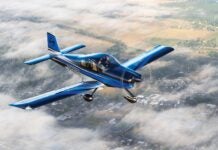
John Stahr continued working on N958PD, KITPLANES Editor-in-Chief Paul Dye’s recently built SubSonex jet on Thursday. With the large area painting completed and detailed art work started, it was another day of mostly detail work… addressing minor flaws in the original spray painting and air brushing on more details. Some of the details were air brushed on while others were shot through stencils… both prepared and made on the spot.










The day ended with clear coat sprayed on the wings. Two coats on the bottom of the wings and three coats on the top. Stahr likes to paint the wings and fuselage separately to avoid build-up at the intersection of the two. Before applying the clear coat, he carefully cleaned the surface with high-pressure air followed by whipping with a dry cloth. Then, it was time to spray. By the time we left the hangar, the wings sparkled in all their glory.



Watch the time-lapse video of day 6:













